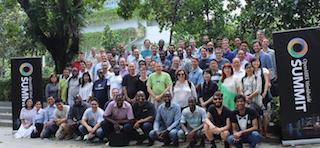 Communicating the IT strategic plan is one of the primary responsibilities of a CIO. Most importantly, the IT strategic plan should be seen as an enterprise wide activity and not just an IT centric exercise. IT should be an enabler for the strategy of the business and every IT tactic should tie back to a high priority of the business. In 2016, the BIDMC IT strategic plan has five pillars that align with quality, safety and efficiency imperatives (instead of Meaningful Use, ICD10, and the Affordable Care Act as was the case 2013-2015). The pillars are:
Communicating the IT strategic plan is one of the primary responsibilities of a CIO. Most importantly, the IT strategic plan should be seen as an enterprise wide activity and not just an IT centric exercise. IT should be an enabler for the strategy of the business and every IT tactic should tie back to a high priority of the business. In 2016, the BIDMC IT strategic plan has five pillars that align with quality, safety and efficiency imperatives (instead of Meaningful Use, ICD10, and the Affordable Care Act as was the case 2013-2015). The pillars are:
Feature Articles
White House Releases Draft Open Source Policy for Federal Agencies
 And that’s why today, to deliver on the commitment made in the Second Open Government National Action Plan, we’re releasing for public comment a draft Federal Source Code policy to support improved access to custom software code. This policy will require new software developed specifically for or by the Federal Government to be made available for sharing and re-use across Federal agencies. It also includes a pilot program that will result in a portion of that new federally-funded custom code being released to the public.
And that’s why today, to deliver on the commitment made in the Second Open Government National Action Plan, we’re releasing for public comment a draft Federal Source Code policy to support improved access to custom software code. This policy will require new software developed specifically for or by the Federal Government to be made available for sharing and re-use across Federal agencies. It also includes a pilot program that will result in a portion of that new federally-funded custom code being released to the public.
Help Us Integrate GitLab and the Open Science Framework
 For years, the benefits of open source code development have been self-evident to the software development community: Transparency leads to collaboration, and collaboration leads to better and more secure code. The scientific community is just starting to understand these benefits. The growing open science movement is using these same lessons to make the scientific process more transparent, so that research findings will be more reproducible. In order to realize the benefits of open science, we must use a wide set of research tools to enable transparency, which will lead to increased discoverability, reuse, and collaboration...
For years, the benefits of open source code development have been self-evident to the software development community: Transparency leads to collaboration, and collaboration leads to better and more secure code. The scientific community is just starting to understand these benefits. The growing open science movement is using these same lessons to make the scientific process more transparent, so that research findings will be more reproducible. In order to realize the benefits of open science, we must use a wide set of research tools to enable transparency, which will lead to increased discoverability, reuse, and collaboration...
Is Shkreli the Exception, or the Norm, in Big Pharma?
 I didn't want to write about pharmaceutical companies. They get enough bad press, and adding to it almost seems like piling on. If Valeant is the poster company for outrage about drug pricing, it's less because what they are doing is unusual than it is because we suspect they are the norm. Honestly, I wanted to discuss McDonald's turning their Happy Meals boxes into VR headsets --I'm not making that up -- but, gosh darn it, it's almost like the pharmaceutical companies are daring me to talk about them. So I will.
I didn't want to write about pharmaceutical companies. They get enough bad press, and adding to it almost seems like piling on. If Valeant is the poster company for outrage about drug pricing, it's less because what they are doing is unusual than it is because we suspect they are the norm. Honestly, I wanted to discuss McDonald's turning their Happy Meals boxes into VR headsets --I'm not making that up -- but, gosh darn it, it's almost like the pharmaceutical companies are daring me to talk about them. So I will.
Halamka's Dispatch from HIMSS
 Every year I walk the HIMSS floor and speak at HIMSS events with the hope that I can distill the conference sensory overload into a few key themes. In the recent past, big data, interoperability, personalized medicine, population health, and wearables were buzzwords in every booth. This year, the buzzwords were replaced by one overarching concept - providers and vendors must innovate or die. In the next 24 months we’ll see an accelerating evolution of fee for service into alternative payment models fueled by MACRA and MIPS
Every year I walk the HIMSS floor and speak at HIMSS events with the hope that I can distill the conference sensory overload into a few key themes. In the recent past, big data, interoperability, personalized medicine, population health, and wearables were buzzwords in every booth. This year, the buzzwords were replaced by one overarching concept - providers and vendors must innovate or die. In the next 24 months we’ll see an accelerating evolution of fee for service into alternative payment models fueled by MACRA and MIPS
Et Tu, Oscar? Are You Reinventing Health Insurance? Or, Just Repackaging an Old Plan?
 I've previously expressed my concern that Oscar and some of its fellow health insurance start-ups might be more about repackaging than reinventing. I'm more concerned than ever after Bloomberg reported that Oscar is adopting a new network strategy: moving to "tight, exclusive networks with hospitals." Oscar CEO Mario Schlosser said: "The bet we made in going deep with a couple of health systems, I love what we’re doing there. We’ve got a very good blueprint now to go into new markets."
I've previously expressed my concern that Oscar and some of its fellow health insurance start-ups might be more about repackaging than reinventing. I'm more concerned than ever after Bloomberg reported that Oscar is adopting a new network strategy: moving to "tight, exclusive networks with hospitals." Oscar CEO Mario Schlosser said: "The bet we made in going deep with a couple of health systems, I love what we’re doing there. We’ve got a very good blueprint now to go into new markets."
Halamka Outlines the Pillars of Beth Israel's IT Strategic Plan
Don’t Let the Dinosaur EHRs Drive Health IT into Extinction!
 Next week is HIMSS16! I’m very excited to go to Las Vegas this year and see so many friends and colleagues and am ready to engage in conversations that will help drive the future of our industry. We have a lot of new technology to show at our booth - changes many of you have been asking to see in Health IT. This kind of change is now necessary because Health IT is running in circles. For too long, Health IT vendors have replaced old technology with different outdated technology. As an industry we can’t tolerate this anymore. Read More »
Next week is HIMSS16! I’m very excited to go to Las Vegas this year and see so many friends and colleagues and am ready to engage in conversations that will help drive the future of our industry. We have a lot of new technology to show at our booth - changes many of you have been asking to see in Health IT. This kind of change is now necessary because Health IT is running in circles. For too long, Health IT vendors have replaced old technology with different outdated technology. As an industry we can’t tolerate this anymore. Read More »
So...Is Paying Ransom What Bitcoin Is For?
 The tech, law enforcement, and privacy worlds are abuzz with the recent decision by Apple to refuse to help the FBI crack the security on an iPhone, even though the iPhone in question belonged to an alleged terrorist/mass murderer. As fascinating and important as that story is, I was even more interested in another cybersecurity story, about a hospital paying ransom to hackers in order to regain access to its own computer systems. This was not the first such occurrence, and it won't be the last.
The tech, law enforcement, and privacy worlds are abuzz with the recent decision by Apple to refuse to help the FBI crack the security on an iPhone, even though the iPhone in question belonged to an alleged terrorist/mass murderer. As fascinating and important as that story is, I was even more interested in another cybersecurity story, about a hospital paying ransom to hackers in order to regain access to its own computer systems. This was not the first such occurrence, and it won't be the last.
Are CMS' Efforts Too Little and Too Late to Save the Collapsing US Rural Healthcare System?
 With 35 percent of rural hospitals losing money and almost two-thirds running a negative operating margin, there’s simply no way rural facilities can invest in health IT without help...It’s clear that CMS understands we can’t leave rural hospitals to fend for themselves. But it also seems clear that a lot of hospitals invested in electronic health records (EHRs) they could ill afford to qualify for Meaningful Use funds—dollars that seldom covered implementation costs for solutions that didn’t yield significant cost savings and required additional technical personnel...“The high capital and operating costs associated with health IT, specifically EHRs, have put some hospitals in a difficult position,” wrote Becker’s Hospital CFO in a prescient January 2014 article. “Do they absorb the financial hit now, even if they know they can't afford it? Most organizations are doing so …”
With 35 percent of rural hospitals losing money and almost two-thirds running a negative operating margin, there’s simply no way rural facilities can invest in health IT without help...It’s clear that CMS understands we can’t leave rural hospitals to fend for themselves. But it also seems clear that a lot of hospitals invested in electronic health records (EHRs) they could ill afford to qualify for Meaningful Use funds—dollars that seldom covered implementation costs for solutions that didn’t yield significant cost savings and required additional technical personnel...“The high capital and operating costs associated with health IT, specifically EHRs, have put some hospitals in a difficult position,” wrote Becker’s Hospital CFO in a prescient January 2014 article. “Do they absorb the financial hit now, even if they know they can't afford it? Most organizations are doing so …”
OpenBionics Makes Low-Cost Open Source Robotic Hands Available to Amputees Around the World
 Doing good for the world is often the nature of an open source software or hardware project. Offering code and schematics to others free of charge and with a license that allows for reuse and modification is often done to help others. Knowing this, I was still surprised to learn about an incredible project that combines robotics and prosthetics. This Instagram video of a robotic hand stopped me in my tracks. Further investigation revealed that the hand is the creation of OpenBionics...
Doing good for the world is often the nature of an open source software or hardware project. Offering code and schematics to others free of charge and with a license that allows for reuse and modification is often done to help others. Knowing this, I was still surprised to learn about an incredible project that combines robotics and prosthetics. This Instagram video of a robotic hand stopped me in my tracks. Further investigation revealed that the hand is the creation of OpenBionics...
Halamka on Enabling Nationwide Interoperability
 ...recently, the ONC Interoperability Roadmap, recognizing that the building blocks of universal interoperability could not be so neatly erected, leans on the idea of “coordinated governance” of networks. While these frameworks have paid homage to the concept of nationwide network as a “network of networks”, we have yet to crisply define the stitching needed to form this nationwide network quilt. This issue hasn’t been so pressing up until now because there were relatively few networks – the “last mile” problem was the bigger concern. Network formation is evolving rapidly, however, which has made more pressing the question of what it means to connect networks in a uniform way.
...recently, the ONC Interoperability Roadmap, recognizing that the building blocks of universal interoperability could not be so neatly erected, leans on the idea of “coordinated governance” of networks. While these frameworks have paid homage to the concept of nationwide network as a “network of networks”, we have yet to crisply define the stitching needed to form this nationwide network quilt. This issue hasn’t been so pressing up until now because there were relatively few networks – the “last mile” problem was the bigger concern. Network formation is evolving rapidly, however, which has made more pressing the question of what it means to connect networks in a uniform way.
OSEHRA Community Responds to the VA's RFI for eHMP Agile Development Contract Strategy
 In recent days, OSEHRA Community Members have enthusiastically collaborated to develop a response to VA’s Request for Information (RFI) for a contract strategy that is suitable for agile development of Enterprise Health Management Platform (eHMP). I would like to thank more than 50 members who contributed in developing the final document that OSEHRA submitted today on behalf of the community. Many members participated in community discussions, shared documents, and provided great ideas. We hope that our response accurately presents the depth and breath of expertise and commitment to excellence that has been shown by the OSEHRA Community.
In recent days, OSEHRA Community Members have enthusiastically collaborated to develop a response to VA’s Request for Information (RFI) for a contract strategy that is suitable for agile development of Enterprise Health Management Platform (eHMP). I would like to thank more than 50 members who contributed in developing the final document that OSEHRA submitted today on behalf of the community. Many members participated in community discussions, shared documents, and provided great ideas. We hope that our response accurately presents the depth and breath of expertise and commitment to excellence that has been shown by the OSEHRA Community.
Test-Driven Development With FHIR
 While preparing for, and participating in, the recent FHIR Connectathon 11 held in Orlando, Florida, yet another benefit of FHIR’s implementer-friendly philosophy became apparent to me – the ability to facilitate Test-Driven Development (TDD). TDD has been defined as “a software development process that relies on the repetition of a very short development cycle: first the developer writes an (initially failing) automated test case that defines a desired improvement or new function, then produces the minimum amount of code to pass that test, and finally refactors the new code to acceptable standards.” Dating back to 2003, TDD is now considered by many developers to represent the state of their art – shining some much-needed light on the darkness might be another way of looking at it!
While preparing for, and participating in, the recent FHIR Connectathon 11 held in Orlando, Florida, yet another benefit of FHIR’s implementer-friendly philosophy became apparent to me – the ability to facilitate Test-Driven Development (TDD). TDD has been defined as “a software development process that relies on the repetition of a very short development cycle: first the developer writes an (initially failing) automated test case that defines a desired improvement or new function, then produces the minimum amount of code to pass that test, and finally refactors the new code to acceptable standards.” Dating back to 2003, TDD is now considered by many developers to represent the state of their art – shining some much-needed light on the darkness might be another way of looking at it!
Hacking the Farm with Low-Cost, Open Source Tool Designs
 After starting his own farm in Missouri, Marcin Jakubowski quickly discovered it's an expensive business. The tools he needed to start and maintain a sustainable farm didn't exist, so he set out to design them himself. Marcin published a collection of his open source designs, called the Global Village Construction Set, to the Open Source Ecology wiki. Soon, just as in open source software, others from around the world began to collaborate with him in designing these new machines. According to the wiki, "Global Village Construction Set is a modular, DIY, low-cost, high-performance platform that enables fabrication of the 50 different industrial machines that it takes to build a small, sustainable civilization with modern comforts...
After starting his own farm in Missouri, Marcin Jakubowski quickly discovered it's an expensive business. The tools he needed to start and maintain a sustainable farm didn't exist, so he set out to design them himself. Marcin published a collection of his open source designs, called the Global Village Construction Set, to the Open Source Ecology wiki. Soon, just as in open source software, others from around the world began to collaborate with him in designing these new machines. According to the wiki, "Global Village Construction Set is a modular, DIY, low-cost, high-performance platform that enables fabrication of the 50 different industrial machines that it takes to build a small, sustainable civilization with modern comforts...
Team Bahmni at the OpenMRS Worldwide Summit
 ThoughtWorks first began contributing to OpenMRS in 2006 and since that time, we've had over fifty committers to OpenMRS in GitHub. Incidentally, one in every seven OpenMRS contributor in GitHub is a ThoughtWorker! Naturally, in 2013, when we had the opportunity to build Bahmni, an open source hospital information system, we choose OpenMRS as the underlying Electronic Medical Records System (EMR). Bahmni leverages the mature data model and APIs of OpenMRS, whilst providing an out-of-the-box system that can be immediately used by hospitals.
ThoughtWorks first began contributing to OpenMRS in 2006 and since that time, we've had over fifty committers to OpenMRS in GitHub. Incidentally, one in every seven OpenMRS contributor in GitHub is a ThoughtWorker! Naturally, in 2013, when we had the opportunity to build Bahmni, an open source hospital information system, we choose OpenMRS as the underlying Electronic Medical Records System (EMR). Bahmni leverages the mature data model and APIs of OpenMRS, whilst providing an out-of-the-box system that can be immediately used by hospitals.